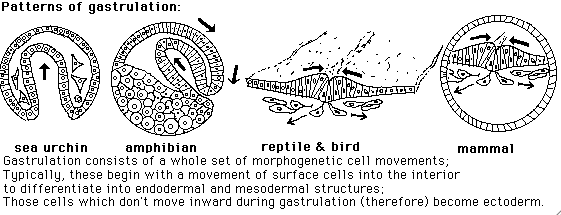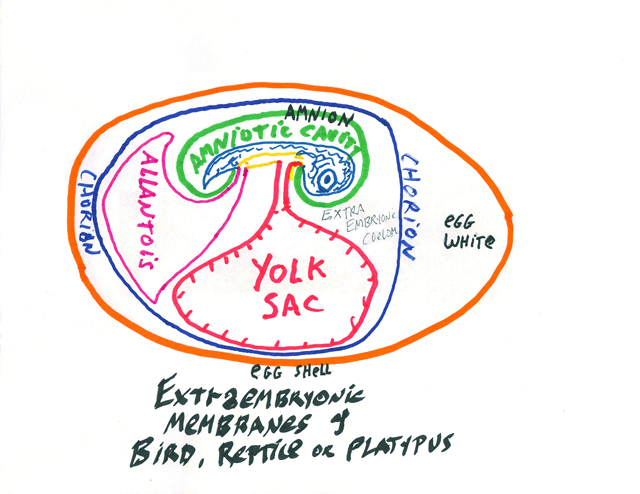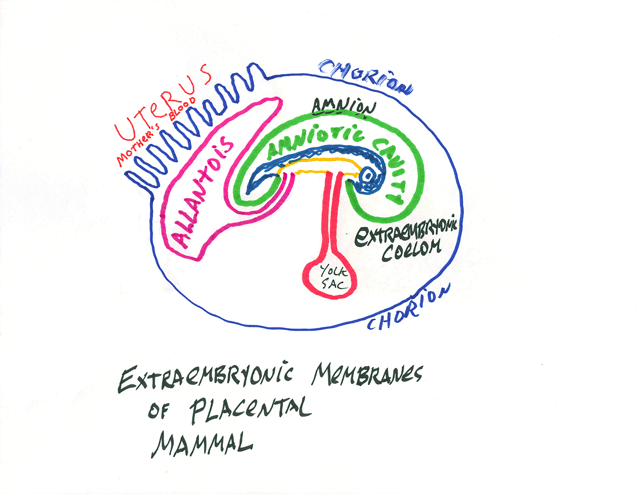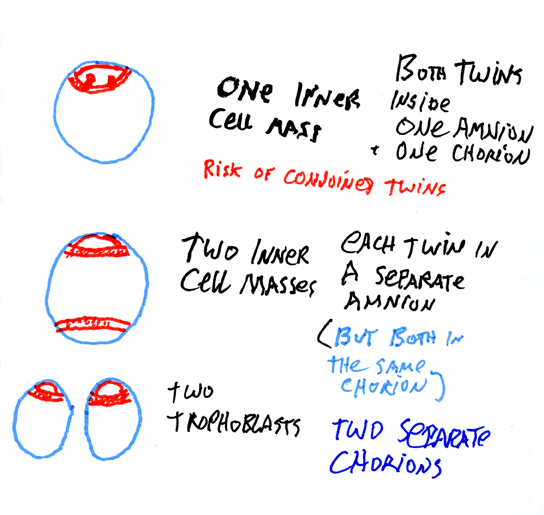Lecture notes for Friday, January 18, 2019
Extra-embryonic Membranes of Birds, Reptiles, and Mammals
Mammal embryos cleave like sea urchins (because mammal eggs have little yolk) but gastrulate like birds (because mammals evolved from reptiles, with lots of yolk)
Meroblastic cleavage: Teleost fish, Birds (& Reptiles)
Holoblastic cleavage: Sea Urchins, Salamanders and Frogs, Mammals
The more "yolky" the oocyte, the more meroblastic the cleavage
The less yolky the oocyte, the more holoblastic the cleavage.
Gar Fish, Bowfins & Sturgeon have holoblastic cleavage (and are NOT teleosts)
Some frogs and salamanders that lay eggs on land have meroblastic cleavage
(and many teleosts are live-bearers, with structures analogous to placentas, but different).
Three species of mammals lay yolky, shelled eggs, with meroblastic cleavage.
Less yolky embryos gastrulate more by invagination or involution.
More yolky embryos gastrulate more by ingression
(except mammal gastrulation is by ingression along a primitive streak,
because mammals continue to gastrulate like our relatively recent ancestors, reptiles.)
Hensen's node is the place on the primitive streak where ingression begins. It is analogous to the dorsal lip of the blastopore in amphibians.
Mammals reverted to holoblastic cleavage but continue to gastrulate like reptiles (which means: like birds).
Something non-typical and extreme about teleosts is progressive formation of body organs, from head to tail. Bird embryos are somewhat this way, but most vertebrates aren't.

The early mammalian embryo is a hollow ball of cells called the blastocyst. Only a small fraction of the cells will become part of the embryo. The rest form membranes and the support structure for the developing embryo.
Reptiles evolved four extra-embryonic membranes:
And then birds and mammals inherited all four of them.


Chorion: Ectoderm & Mesoderm
-
Surrounds all the rest (of the embryo and the other e.e. membranes
Is in direct contact with the uterus (in mammals)
[of course, mammals are the only vertebrates that have uteruses]
Amnion: Ectoderm & Mesoderm
The space enclosed inside the amnion is the "Bag of Waters".
Yolk sac: Endoderm & Mesoderm
is an outpocketing of the middle of the digestive tract
(Stores yolk for food)
Allantois: Endoderm & Mesoderm is an outpocketing of the hindmost part of the digestive tract (Stores urine) (very well-developed blood vessels)
Birds and mammals inherited all 4 of these extra-embryonic membranes.
("extra" in this sense means "outside", rather than "more than usual")
The umbilical cord connects all four of these to the body itself,
and contains two arteries and one vein.
(Urine can sometimes squirt out of the belly button in young babies)
Turtles, snakes, lizards sometimes hatch with a large yolk sac protruding from them. This will be physically retracted into the body in a few days; don't cut it off!
Many species of snakes incubate their eggs inside the uterus, instead of laying eggs.
Most reptiles have flexible "leathery" egg shells. Indentations in reptile egg shells often push on early embryos, which can result in two-headed offspring.
In mammal embryos, the body develops out of part of the inner cell mass. The large sphere of cells ("the trophoblast") develops into the chorion.
Mammal embryos digest a pathway into the wall of the uterus "endometrium" and crawl down into it until completely surrounded by uterine cells. (This digesting & burrowing is called "implantation")
digest through uterine tissues, including blood vessels,
so that blood flows directly across the part of the chorion where the allantois is just inside.
Advantage: better permeability
Disadvantage: more bleeding & difficulty at the time of birth
Pigs, horses and many other kinds of mammals have much less of this tissue removal.
Note: There is no kind of animal in which the circulatory system of the mother ever connects directly to the circulatory system of embryos (like a trailer hook-up).
Three alternative causes of identical twinning:
If both twins are enclosed in the same amnion, then there were 2 primitive streaks in the same inner cell mass (and they will also be inside the same chorion). This happens in about 1% of identical twins. This is the only case in which formation of conjoined twins is possible.
If both twins are together inside the same chorion, but each separate in their own two amnions, then they developed from two separate inner cell masses, inside the same trophoblast. About half of identical twins develop this way.
If twins are both in their own separate chorions, then they developed from separate trophoblasts, and might not be identical twins.
Incidentally a very great immunological discovery was accidentally made by using skin grafts to (try to!) distinguish between cattle twins that were genetically identical versus which were "fraternal" twins.
Researchers expected that only non-identical twins would "reject" organ grafts from each other.
But immune tolerance VERY unexpectedly developed in non-identical twin cattle.
Their immune systems didn't attack each other! Can you figure out, or guess, why not?
(Note: this doesn't occur in human twins, for some unimportant reason.)
Videos shown in this lecture. We will return to these next week.
animation of cleavage in a frog egg
video of early cleavage in a frog egg
Disadvantage: worse permeability; urine actually gets stored in allantois
animation of teleost gastrulation (epiboly)